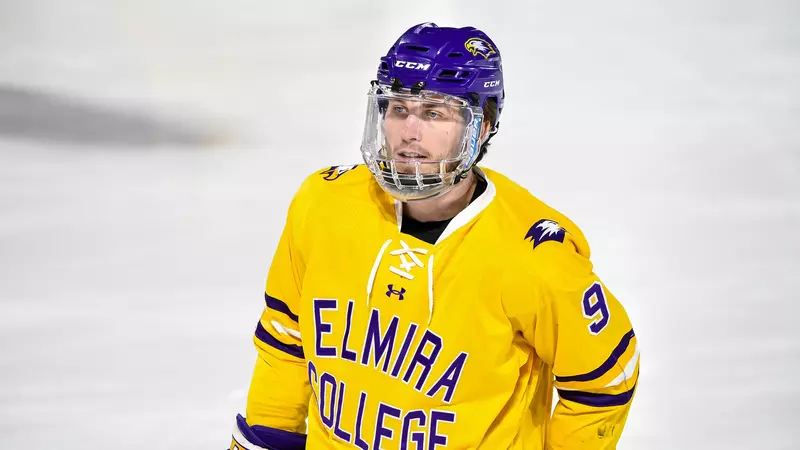
The adjustment from living at home to moving off to college can be a big one. Imagine doing it as a student-athlete, older than all other freshmen, and the college you are going to is in another country. For Joel Pavey ’25, Matt York ’26, and Kyle Curtin ’26, these revelations were realized soon after living and playing hockey in Canada before deciding to play for the Soaring Eagles.
All three came in as overaged freshmen, a term used in the college hockey community to describe players who begin their first years after turning 20. All three have also learned lessons about preparation, the differences between the junior game and college game, and how they can rely on themselves more than they ever thought.
Pavey cited the smaller ice and more physicality as things he noticed right away coming from the Navan Grads of the Central Canadian Hockey League. “The college game is definitely more of a pro game than a ‘run-n-gun’ type of hockey in juniors. [There’s] a lot more offense in juniors than in college. I think we’re definitely more focused on a defensive game and not allowing pucks to go in our cage,” said the Sarnia, ONT native.
“I would say some of the biggest adjustments are in the defensive zone because in juniors you can get away with flying the zone, maybe not supporting the puck. Here, [our coaches] have made it a focal point for us to prioritize defending first and playing from the defensive end out,” said Pavey about the team’s style of play.
Pavey first learned about Elmira through his friend Calvin Hughson ’20. Hughson, now a police officer in Sarnia, played for the Soaring Eagles and knew head coach Aaron Saul ’98. “He is a good guy, good player, I trusted his advice,” shared the senior forward. Pavey, a criminal justice major, is excited to follow in his friend’s footsteps and hopes to work in the force.
Now, with new rules in place between the NCAA and CHL, Pavey thinks that “anywhere in the NCAA is a very strong opportunity to [continue] careers as a hockey player and a person. It doesn’t leave much room for anyone who is not ready to step in and make an impact. I would take the time to look at a program and see what opportunities there are for you as a player and a person based on what you’re looking for in your college career,” Pavey advised younger teammates from juniors about whether or not they should give college hockey a shot.
Pavey lived in the US for the 2018-19 season when he played 43 games in the North American Hockey League for the Minnesota Magicians. The following season, he played in 23 games for the Magicians before joining the Grads. His time spent in Minnesota helped prepare him for living in the US almost year-round. Reflecting on his time living alone now, Pavey shared that it has made him grow as a person. The biggest struggle for the senior was making himself a pregame meal. Being away from family is also something Pavey doesn’t enjoy but knows he can still lean on them.
During the summer, when he goes back home, Pavey skates with other players from the Sarnia area. The group consists of other college players, junior players, and a few pros.
Typically, when Canadian players arrive at their college, they begin as a 20-year-old freshman. Pavey, York, and Curtin all came to EC after turning 20. In their minds, the extra years playing juniors is a positive because of the extra maturity. Also, in cases like Pavey, the late-bloomer effect comes into play where some players don’t jump onto the scene until their age-19 or age-20 season.
On the flip side, the group does find that not having to deal with academics for the previous years while playing is an adjustment.
One thing that caught York’s eye when looking at the difference between college and junior hockey is the length of the season. The standard junior season lasts 60 games before playoffs while the college campaign runs the same calendar but only schedules 25-30 games each year before playoffs. “Every game counts more, it’s more special,” York said.
York also mentioned the league allowing the players to wear visors on their helmets, drop the gloves, and overall take more penalties when playing junior hockey, saying, “It’s a lot more structured here.”
York realized when he came to Elmira that he needed to play “strong defensively” by using his stick more and not having to rely on his body as much. “Guys are older, faster, stronger. So you have to be able to defend using your stick and not just defend using your body.”
York’s friend Nicholas Domitrovic ’24 was a sophomore when York was going through the recruiting process. The pair played two seasons together with the Kemptville 73s of the CCHL. York, who had been looking at colleges, visited Elmira and knew that this was the place he wanted to be.
The blueliner played his entire junior hockey career in his hometown, so the adjustment was a bit bigger for him. “It’s my first time away from home. Food is different. I just have to rely on myself more for things like laundry, making my own meals, or just going to the meal hall, timing my days better, and being more independent.”
Coming in as an overaged freshman, York found himself “more mature as a person in general. I didn’t think I was ready to go to college. Right out of high school, I had a lot of thinking to do. I don’t think a guy could come out of high school and be ready to play [Division III]. It’s better to take the time and just be ready when you come in and actually play rather than coming in younger and never really hitting your stride at this level.” Essentially, York’s lesson to himself was: to be ready to play.
One thing York admitted was hard to see as an overaged freshman was friends moving on. “I think it’s more of a mental thing. You’ll see a lot of your friends moving on and you’re not. You’ll see your friends at school, even graduating and getting jobs before you. At the end of the day, I don’t think that is too big a deal, I’m not really in a rush here.”
York’s brother, Jack, a senior defenseman, plays at Western University Canada. Matt credits Jack as having a big impact on his career. The brothers played together with the 73s for a season before Jack moved on to the Ontario Hockey League.
For Curtin, seeing the game as a goalie is the main thing he noticed coming from the junior game. “The speed of the game and the plays that are being made,” were things the 23-year-old goalie realized were not the same.
The Soaring Eagles’ top goalie played the bulk of the schedule last year and likely will do so again. Having the length of his season essentially cut in half, Curtin knows he has to have it every game, saying “In juniors, there’s 60 games so near the end of the season, you can be in a playoff spot with 20 games left. Here, it’s a lot more competitive. The games mean more.”
Curtin said his main advantage in coming in as an overage is the experience. “The four years of junior experience really helps a lot.” Curtin’s only real negative from coming in later? The schoolwork. “Being behind a bit, school-wise, on homework and learning. Just have to adapt again to the change.”
The St. George, ONT native sees the game here as a physical, agreeing with Pavey. “Guys are blocking more shots, working harder in front of the net. You see more low-scoring games. You definitely have to look around more bodies in front and fight your way through it.”



